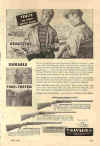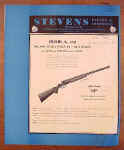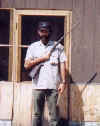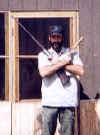The Old Farm Gun:
Stevens
Model 94 20 gauge
Update: see the link at the bottom.
(Free permission to quote
Church's articles is granted, as long as proper attribution is given. We request that if you use our work, you give us credit.)
My
friend Jack, living in an inner city apartment, recently had a rural acreage
handed to him, along with a small house and some livestock. He wanted to become
more self sufficient, and this was an ideal chance. As I write this (May 2001),
he is spending time trying to make repairs to the property, and hopes to be
living in Missouri Amish Country by the end of summer.
We
discussed firearm needs. The most common guns on Ozark farms seem to be:
(1)
Shotguns of various types, pumps and single shot most typical. These are
extremely common.
(2)
.22 rifles, with the Ruger 10-22 very much most common. Most farms and rural
residences also seem to have some sort of .22 rifle.
(3)
Deer rifles, with the lever action .30-30 predominant.
(4)
Handguns, with a great diversity of types. Rimfire and centerfire, revolver and
semi-auto. These are the least
common, but certainly have a place in some farms and retreats.
His
budget was limited, and he felt unprepared for used gun shopping. Then he was
given the subject of this article, a 1940s or ‘50s vintage Stevens Model 94 20
gauge.
Right side of the Stevens 94
(Click on any thumbnail below for a larger photo.)
Tenite: Better
Living Through Chemistry
The test piece is a completely conventional breakopen single barrel in every mechanical respect. It chambers the 2 ¾ inch 20 gauge, has an ejector of fair force, and is apparently choked modified. Stevens made some manner of single shot breakopen shotgun designated as the 94 for years, at least into the mid 1980s. Using, however, wood. 1951 MSRP was $20.80, according to the amazing Lancer of Georgia and his ’51 “GUN DIGEST”.
This
one differs from other single shots of the period in being stocked with Tenite,
an Eastman Corporation synthetic much used in the 1930s for automotive parts. It
weighs considerably less than wood and is quite stable. According to the fine
Larry Sterrett article (“Tenite
and the early synthetics in the Long Gun Industry”, 1997 “GUN DIGEST”),
Tenite was announced as a stock choice in 1939, put in use in 1940, shelved for
WWII, reintroduced in late ’45 or ‘46 and officially used until 1950.
Apparently some old inventory of stocks got used up, and this continued until
1954. I can remember in the 1970s Numrich Arms selling Tenite stocks, and
cheaply. The ’97 “GUN DIGEST” is particularly dear to me, as another
article mentions me by my real name.
Tenite
can be molded to precise shapes, and therefore offered some advantages for
gunstocks. It is not a particularly cheap product, and certainly didn’t poison
the well for subsequent Tupperware Ordnance-the Remington Nylon 66 rolled out
the same decade as the last Tenite Stevens. The Glock is now the standard cop
pistol of North America.
Left side of the Stevens 94
Jack’s Gun
The
buttstock on the test gun showed some minor shrinkage after 50 years against the
rear of the receiver. Hollow, it drops the weight of the gun down to 5 ¼
pounds, vs. the 6 pounds of the wooden stocked guns listed in my 1968
“SHOOTER’S BIBLE”. Handling is fast and actually seems pretty precise.
A
Stevens Model .22-.410 I have handled has had a constant working life since just
after WWII, and its Tenite appurtenances have held up better still. That said,
it has sustained the recoil impulses of an 8 pound .410, rather than a 5 pound
20 gauge.
The
buttstock carries some molded checkering, and has sustained a few dings,
scratches and one deep gouge. The exterior of the buttstock and fore-end overall
is as shiny as a rearview mirror. The fore-end is attached to a conventional iron,
and is cleaner than the buttstock by a good margin.
The
series was offered in 12, 16 and 20 gauge, and .410 bore. 28 gauge was at least
catalogued (1968 “SHOOTER’S BIBLE”), and in a 1987 reference, 10 gauge. 20
gauge, as used in this shotgun, was a good choice for the lightweight Tenite
variation. Far more useful than .410, the noticeable recoil of 7/8 ounce shot
vs. 5.25 pounds of gun makes you glad it isn’t a 12 gauge.
Disassembled
Finish
on the receiver and fore-end iron is gray, turning brown. The barrel, hammer,
trigger and top lever is blue, with a good many spots of rust. The trigger guard
is non-ferrous with a black enamel finish. The trigger guard paint has not held
up well.
Two efficient methods of pest control: Cat-Stevens
Markings
on left of receiver:
STEVENS
MODEL 94
SAVAGE
ARMS CORPORATION
CHICOPEE
FALLS, MASS. U.S.A.
Markings
on left of barrel:
PROOF TESTED – 20 GAUGE
-2
¾ INCH CHAMBER-
Markings
on right of barrel:
SELECTED
FORGED STEEL
No
serials anywhere.
Choke
markings are totally absent, but the 1968 “SHOOTER’S BIBLE” lists only
full choke for all gauges. That
isn’t how this one shot, so a mystery emerges.
Shooting
Jack’s gun:
Three varieties of Federal 7/8 ounce field loads were tried, all discount house specials: #7 ½, #6 and #4 shot. All shot excellent well distributed modified patterns. I have a sneaking suspicion this gun really is choked modified rather than full, but nothing indicates the factory ever offered them that way.
I managed to get no patterning photos. Other illustrations are underlit, as I bought 400 instead of 800 speed film (Kodak, parent of Eastman Tenite), and had my flash batteries fail.
Recoil
was noticeable, and after 10 rounds in rapid succession, my 42 year old shoulder
complained and turned color.
I
am not a wingshot, but hand-thrown targets seemed to be well within reach of the
fast handling little smoothbore.
This giveaway used shotgun far exceeded our expectations as far as shooting.
Shown with a $1 bill for scale
Dimensions: Test Gun
Barrel: 28 inches, 2.75 chamber.
LOA:
42 inches
Pull:
13.5 inches, drop @ comb 1.5 inches, drop @ heel 2.5 inches.
Weight:
5.25 pounds
Operation,
takedown, and reassembly:
The Stevens 94 is an absolutely typical single shot breakopen shotgun. To load and fire, push the opening lever behind the hammer in either direction. Pull down on the barrel. The barrel will swing open, exposing the chamber. Load one round of ammunition (for this ancient one, 2 ¾” 20 gauge), and close the barrel. Cock the hammer, pull the trigger, and boom it goes.
Push the opening lever again, pull down the barrel (our gun is smooth enough to drop the barrel under gravity), and it will eject the empty with fair force.
To disassemble the gun, pull down on the tip of the forearm. Remove forearm. Holding the barrel, push the opening lever, and controlling the barrel, tip the barrel down. Once open, the barrel can be pushed back slightly from the hinge pin, and lifted away from the receiver. If not controlled, the barrel can fall out of the receiver, possibly damaging it, and certainly scaring the bejabbers out of Shadow the Tomcat.
To reassemble, replace the barrel in the open position against the hinge pin. Then gently rotate the barrel to the closed position. Position the fore-end with the iron against the receiver face and carefully position the spring against the lug on the bottom of the barrel. On the well worn test gun the spring and lug had to be positioned carefully indeed. Snap the fore-end in place.
In
the role of the cabin gun:
The takedown aspect makes the old scattergun convenient to store, although Jack intends to put it on two stag tips nailed above the kitchen door. It has weathered 50 years of use quite capably, and I strongly suspect with a spare ejector and firing pin (still available from Gun Parts), it has another 50 years left.
The slicky-slick texture of Tenite leaves the elastic buttstock ammo carrier slipping around, so I am having a leather lace-on made for him by Bill Beumer's Baldknobber Holsters, 1-417-844-2174.
Bombard Church with Email on any subject: akchurch@bigfoot.com. See bottom of page for viewer emails.
NOTE: Author Church regrets that he is unqualified to do appraisal, and cannot establish a value on your gun.
Jack & Xote
To Protect and Serve. The goats and anti-coyote measures.
Action open, Stevens 94 over the cabin porch door.
Stevens closed, another view of the porch side of cabin.
Working guns are a Norinco Tokarev 7.62 m/m, and Stevens 94. The Spanish percussion pistol now lives with Otony.
Not sure there's enough chat in the world for his road.
The garage. The Husky just needed new tires.
Jolly Jack with his working guns
Update! The Old Farm Gun part II by The Lone Gunman and AK Church (posted 5-28-2002)
AK likes to attach useful or interesting letters from readers to his articles. Please state in your letter if he may use your correspondence. He can do this with or without your name or address, according to your wishes. Email him here.
And speaking of Email:
I remember a story regarding those Tenite stocks. As I understand it, the recoil was pretty bad. Two guys I know were dove hunting. There were plenty of doves, but the fellow telling the story noticed that the other guy was not shooting any more , although there were still doves flying over. He asked the other one why he had stopped shooting. The man unbuttoned his shirt and showed him his shoulder which was already turned blue from the recoil. That is probably one reason why the gun you shot is in good condition. Those H&R Youth Models in 20 gauge chambered for 3" shells have very stiff recoil. I think they weigh under 5 lbs.
But anyway, that single shot break open shotgun was very common in the 40's when I was growing up in rural Arkansas
Havis
Nice
article on the Tenite. My first shotgun was one of those in 16
gauge when I was 12. What a mule kick that thing delivered. Like
you
mentioned, one does not tend to do a lot of shooting at one time with
such a gun. Your article brought back fond memories, and yes mine was
in modified choke so stated on the barrel.
Larry T.
(posted 15 Aug 2002)
Ak,
I enjoyed reading about the Tenite stocked shotgun. Back in about 1960 when I was a whole 12yrs. old, I had been after dad for 3-4yrs. to purchase a shotgun. His standard reply when I would make the request you didn't ask to often if you knew what was good for you was that you could kill anything that needed killing with the family .22. Also he liked to make VERY sure that something was actually going to be useful before purchasing, but his only experience with shotguns was an old [approx 1908] Western Arms 12 ga. that belonged to my granddad. He always said that that old long barreled 12 killed about everything that it was pointed at. Knowing the frugality of my granddad, I'll bet it never had over a box of shells bought and shot through it as shells were only purchased 2or3 at a time!
Yes, I'm talking individual shells, not boxes. So when he finally surpised me one day when I came home from school, It was with a 12ga, 94,you guessed it, Tenite stocked. It was lovely and graceful, shouldered and pointed with speed and it kicked harder than the 16 year old bully at school could punch! To the best of my memory it was marked full choke, but TALK about your false advertising when I would shoot a load of HI Brass Peters #6 [purchased 3to5 at time, they cost 10 cents each in 1960 at the local general store] at a sitting squirrel in the top of a tall tree I only got them about 50% of the time about the same as my average with the .22. Somewhere along the line I acquired some #8's and that is where I learned my lesson about patterning a shotgun before hunting with it, I was out in the back yard with the old 12 and We had recently installed indoor plumbing in the old farmhouse, dad being gone for the day I decided to shoot the old outhouse with a load of the #8's. I backed off about 20yds from it and let it have it. Rubbing my shoulder, I strolled up to it looking for a turkey shoot pattern and to my amazement it had shot scattered from top to almost the bottom of it, with holes in the pattern big enough to throw a chicken through without touching a shot. It had the choke of a blunderbuss! From then on I pretty much give up on shotguns till I got older and could afford one of my own. It was hell on moving game at extreme close range, but a quick point and loose shouldering made you pay a hell of a price when you touched her off. Would've been a hell of a crowd control gun.
I have since owned a 16 and .410 with Tenite stocks and they were much better than that old 12 ga. Presently own a .22 semi-auto that has a Tenite stock, purchased from an aunt after an uncle passed on. Nice gun.
Thanks,
(name withheld by request)
P.s. You can do what ever you want with this email, even run it through the printer and give it to Jack to replace the Sears and Roebuck in the outhouse on the homestead, ha, ha, ha!
Added 02 April 2003:
Dear sir, I
have recently looked at your site about your model 94
I have a very old shotgun similar to yours. The only words
on it say "Volunteer". It is a .410 and every part
has a serial number. It is a single shot auto eject and is a
single action. It was given to my grandfather in the
Christmas of 1935 by his dad and was bought from a hardware
store. A man at the NRA told me it could be either a Stevens
model 94 or 107. if you have any information it would be
greatly appreciated.
sincerely,
Micah (email
provided by request)
Added 21 July 2003:
Church,
Thanks for your web page "The Old Farm Gun". While growing up my Father had two shot guns he keep in the closet. Since we lived in the suburbs the guns rarely saw the light of day. One was a bolt action 20 gauge with a three shell clip that my mother purchased for him at Sears. The other a Stevens Savage 16 Gauge single shot Model 94C that belonged to his Father. I had shot the 20 gauge a few times but always wanted to try the 16. A few years after my Father's passing I got the old shot gun and cleaned it up, bought a box of shells and made out to the woods of North Alabama where I now live. I set myself up a nice target, took aim and squeezed the trigger. After picking my 120 pound self up off the ground I decided that the gun would make a great show piece. I was also unsuccessful at locating any remnants of my target so I guess I hit it.
It is very obvious to me now why the gun is still in excellent condition.
Charlie Dilmore (name & email address used with permission)
visitors since website crashed AUG
2003





















